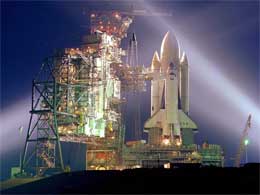 CAPE
CANAVERAL, Fla. - What if the next space shuttle winds up
in trouble, too? What if, like Columbia, it's damaged at
liftoff and the astronauts are up in space with a maimed
rocketship? Could they be saved? CAPE
CANAVERAL, Fla. - What if the next space shuttle winds up
in trouble, too? What if, like Columbia, it's damaged at
liftoff and the astronauts are up in space with a maimed
rocketship? Could they be saved?
When Discovery is launched in a few months,
a four-man rescue squad will be standing by. It's a plan
for the unthinkable.
"It's a place where we don't want
to go. We're training for a mission we never want to fly,"
says the team's commander, Air Force Col. Steven Lindsey.
A rescue mission - which might require
the president's approval - is fraught with complexities:
- A second launch would have to be done
hastily without all the usual tests, possibly putting
the rescue shuttle - Atlantis - and its crew in harm's
way.
- The astronauts on the first shuttle,
Discovery, would hole up at the international space
station. Designed to house three people, it would be
crammed with nine. And everyone would hope the station's
often-broken oxygen generator would do its job.
- Discovery would have to be pushed off
by remote control into the ocean to make room for Atlantis
at the space station.
- If all worked as planned, Atlantis
would return to Earth holding an unprecedented 11 people.
And even if NASA managed to pull off this
nightmare scenario, it would likely mean an end to the
shuttle program five years before its time.
Never before in 44 years of human spaceflight
has NASA gone to such lengths to have a spaceship ready
to rush to another's assistance.
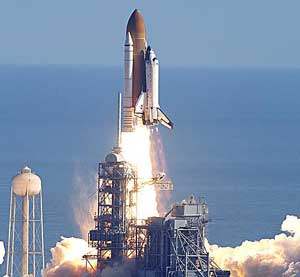 At
Kennedy Space Center, hundreds of employees are toiling
24/7 on this possibility. Discovery can't lift off unless
Atlantis is ready to fly one month later. It is a self-imposed
requirement for the next two shuttle flights and goes
beyond the list of recommendations from the panel that
investigated the Columbia accident. At
Kennedy Space Center, hundreds of employees are toiling
24/7 on this possibility. Discovery can't lift off unless
Atlantis is ready to fly one month later. It is a self-imposed
requirement for the next two shuttle flights and goes
beyond the list of recommendations from the panel that
investigated the Columbia accident.
And so it is that Atlantis and Lindsey's
minuteman team stands poised. If Discovery goes up in
mid-May as planned, NASA says it could launch Atlantis
as quickly as mid-June, a month sooner than scheduled.
"I'm ready to do it and I figure
probably in that one-month period, I wouldn't go home
anymore, probably sleep in my office," says Navy
Cmdr. Mark Kelly, Lindsey's co-pilot.
If seven friends were up in space and
needed to get home, Kelly says, "I'm willing to take
a lot of risk to do that, and I understand that, and it's
not a decision I will have to make later. I've already
made that decision."
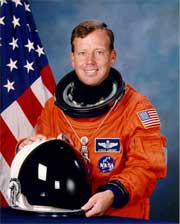 |
Commander
USAF Col. Steven W. Lindsey |
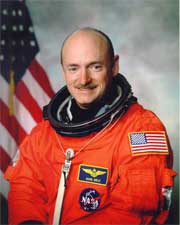 |
Pilot
USN Cmdr. Mark E. Kelly |
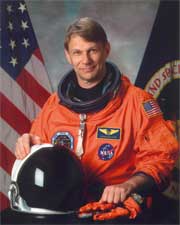 |
Mission Specialist
Piers Sellers, Ph.D. |
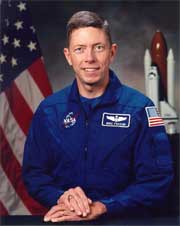 |
Mission Specialist
Michael E. Fossum |
It is this cool steadfastness and unwavering
ability to focus on the ordinary mission - a service call
to the space station in mid-July - as well as a nightmarish
one, that makes Lindsey, Kelly, Piers Sellers and Air
Force reservist Michael Fossum seem as though they've
stepped out of "The Right Stuff."
As it turns out, the four were not hand-picked
because of their larger-than-life flying skills or lightning-fast
thinking.
They just happened to be next in line
for launch.
All four are in their 40s with children.
All but Sellers is an engineer; he has a Ph.D. in biometeorology.
All but Fossum have flown before in space.
Combat Vets
Lindsey and Kelly are former test pilots,
and Kelly - whose identical twin brother, Scott, is also
an astronaut - flew combat in Operation Desert Storm more
than a decade ago.
The British-born Sellers joined the crew
a half-year late, replacing an astronaut who was yanked
for undisclosed medical reasons.
As Lindsey sees it, the odds of Discovery
being gouged by foam debris from the fuel tank at liftoff
and its seven astronauts being stranded at the space station,
are very low given all the improvements in the two years
since the Columbia tragedy.
"I'll tell you what, if we aren't
absolutely as confident as we possibly can be that we
have fixed the tank, which is our primary rationale to
go forward, then we have no business in launching,"
he said.
Lindsey has promised his wife and three
children if he senses anything unsafe for this mission
or any other, "I'll walk, I won't fly."
Earlier this month during a simulation
of Discovery's upcoming flight, NASA's mission managers
held a dry run of the debate that would take place if
Discovery were damaged on liftoff. In the make-believe
scenario, the shuttle was struck at launch presumably
by breakaway foam insulation - just as Columbia was.
With the clock running, flight managers
had to decide whether the craft could make it home with
patches or whether the astronauts needed to move into
the space station and await rescue. The managers opted
for patch work.
"Hopefully, the probability is so
low that we are just covering ourselves, belt and suspenders,"
the shuttle deputy program manager, Wayne Hale, said during
the simulation.
In real life, back in January 2003, no
one knew that a chunk of foam had punched a sizable hole
in Columbia's left wing. NASA knew the foam hit somewhere,
but discounted the possibility of catastrophic damage
and, after being proved wrong, contended there was nothing
they could have done to save the crew even if they had
known about the damage.
The Columbia accident investigators didn't
buy that. An exhaustive study found that contrary to NASA's
initial claims, the space agency could have launched another
shuttle to rescue the seven astronauts who ended up perishing
on their way back to Earth.
If Atlantis is called upon for rescue,
launch director Mike Leinbach says he would use the same
engineering and weather criteria he always uses to get
that shuttle off the pad. But from a personal perspective,
the countdown would be unlike anything before.
"It would just be another one of
those, I don't want to say, empty feeling like I had the
day that Columbia didn't come home," Leinbach says.
"It's impossible to describe the emotional feeling
that everyone would have launching the rescue mission.
But we would do it if so told."
NASA's main concerns, for now, are getting
Discovery ready for a mid-May launch and Atlantis ready
for a possible mid-June emergency launch, and keeping
the space station running without more major breakdowns.
Being stuck at the space station and awaiting
rescue would have its own problems. One of Discovery's
astronauts, Andrew Thomas, who lived aboard Russia's space
station Mir seven years ago, says it's the psycho-social
aspects that would concern him most.
"What would we do on a day-to-day
basis?" Thomas asks. He points to history for the
answer. Successful missions in tough situations have hinged
on crew members constructively working on their own day-to-day
survival. "You just have to look at what Shackleton
did," Thomas says.
In the classic survival tale, Sir Ernest
Shackleton in 1915 guided his crew of 27 back to safety
after their ship became trapped in the ice of Antarctica.
To keep up morale, he staged concerts, holiday celebrations
and sports matches.
A piano keyboard is up on the space station,
"and maybe one of us could learn to play the piano
while we're there," Thomas says with a chuckle. "You
remember that movie, 'Groundhog Day?' That's what the
Bill Murray character did when he was caught in sort of
a supposed never-ending cycle."
But then Thomas turns serious again: "It
would be a stressful situation."
He is convinced the astronauts could be
saved, but the danger would be the premature death of
the shuttle program, which is to be phased out in 2010.
"It would be hard for me to imagine
that were there another major failure like this that Congress
would not look askance at the shuttle program and say,
'Hey, we're done with it.'"
|